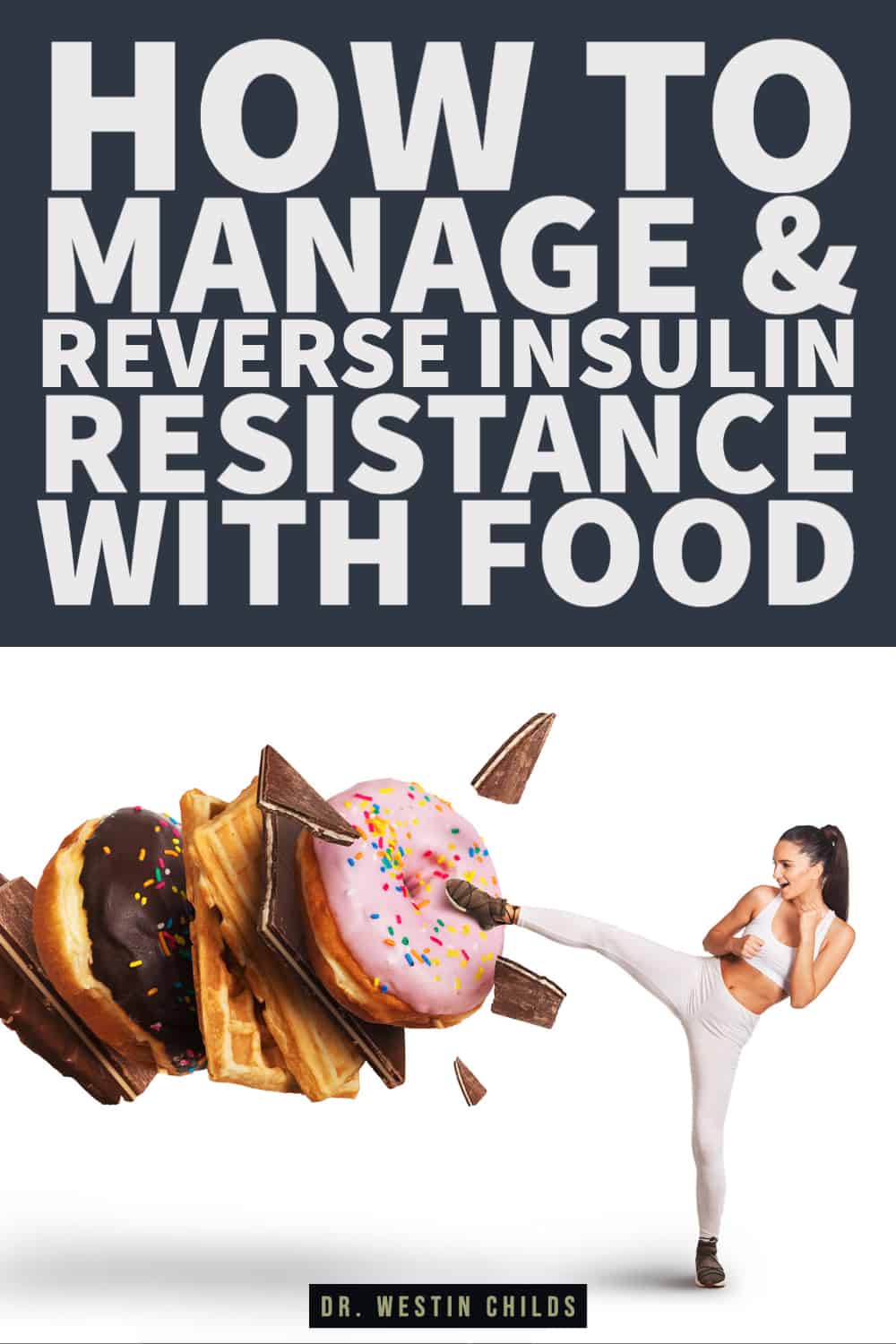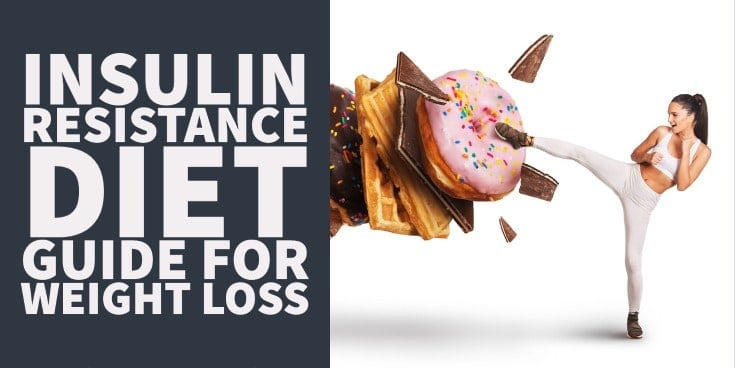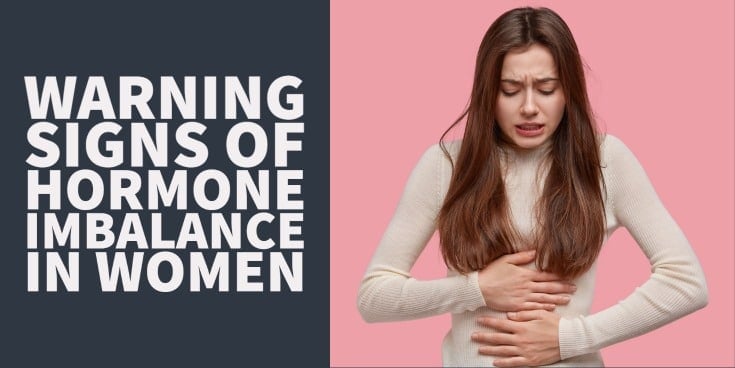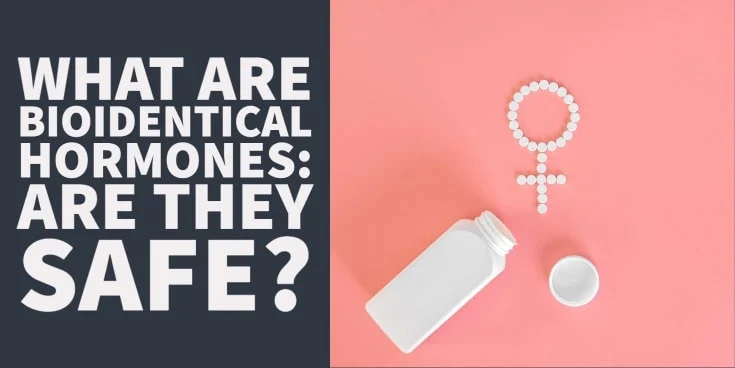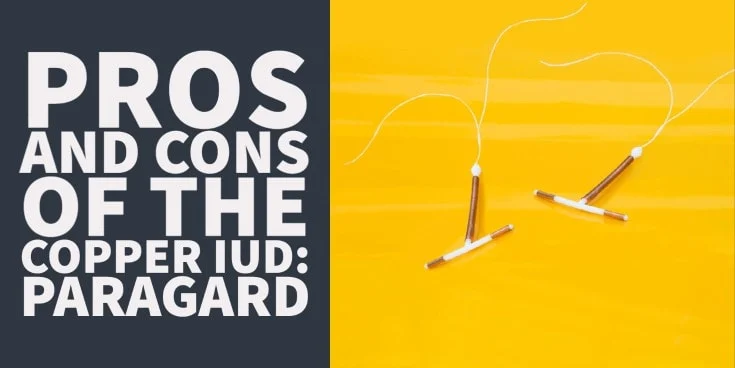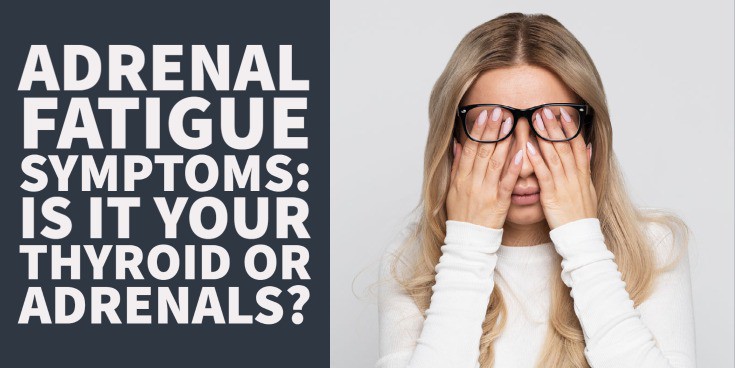Is insulin resistance, diabetes, or pre-diabetes making it difficult or impossible for you to lose weight?
If you fall into this category you probably understand that for the most part insulin resistance is a DIETARY disease.
Meaning you most likely have this condition because of the food you’ve eaten (or are currently eating).
Understanding this concept is very important because if you understand that insulin resistance can be caused (and worsened) by diet it is also true that diet can actually help to lower insulin levels and reverse insulin resistance.
But hold on.
I have some good news for you and some bad news…
First the bad news:
Most Doctors and patients approach insulin resistance all wrong which leads to higher insulin levels and more weight gain over time.
But, here’s the good news:
I’m going to walk you through how to approach insulin resistance through diet, medications, and supplements.
Because the best way to treat and reverse insulin resistance is with a comprehensive approach:
Let’s talk about what foods to eat, what foods to avoid, how much food you should be eating, what type of macromolecules you should consume on a daily basis, and much more…
Understanding Insulin Resistance
Before we talk about diet and interventions for insulin resistance you really need to have a basic understanding of what insulin resistance is and WHY you would even want to treat it.
This is the beginner’s guide to understanding insulin resistance, diabetes, and pre-diabetes:
Insulin is a hormone that is secreted from your pancreas in response to two macromolecules: glucose (sugar) and protein.
Its primary job is to move that sugar inside your cells so your body can burn them for energy.
It can put this glucose (energy) into all cells including your fat cells.
Why?
Because your body isn’t stupid! If you eat a meal that is high in sugar your body recognizes that all that sugar can be used for later, so it pumps out insulin in response to hold onto the energy and store it for later.
So that’s how it is supposed to work.
But what is insulin resistance?
Insulin resistance is when the system starts to go haywire.
So imagine that you’ve been consuming large quantities of sugar (think of Pepsi, Coke, etc.) for years and years.
You have to realize that glucose (sugar) is both a good and a bad thing for your cells.
On the one hand, it wants the sugar to store for excess energy later (inside your fat cells), but sugar can also be toxic in large amounts to your cells and tissues.
Think of pouring syrup into your computer and you can imagine what is happening inside your body.
So your body creates a protective mechanism to prevent the damage from happening.
Eventually, your cells and tissues start telling your body they can’t handle any more of the sugar.
They do this by downregulating the receptors to insulin.
That means that insulin doesn’t work quite as well so your blood sugar naturally increases.
This process worsens over time and both your blood sugar and insulin levels rise eventually, doctors will spot the high blood sugar and label you with pre-diabetes or diabetes.
Does this sound familiar?
The crazy part is this process is currently occurring in about 50% of people in the united states (1).
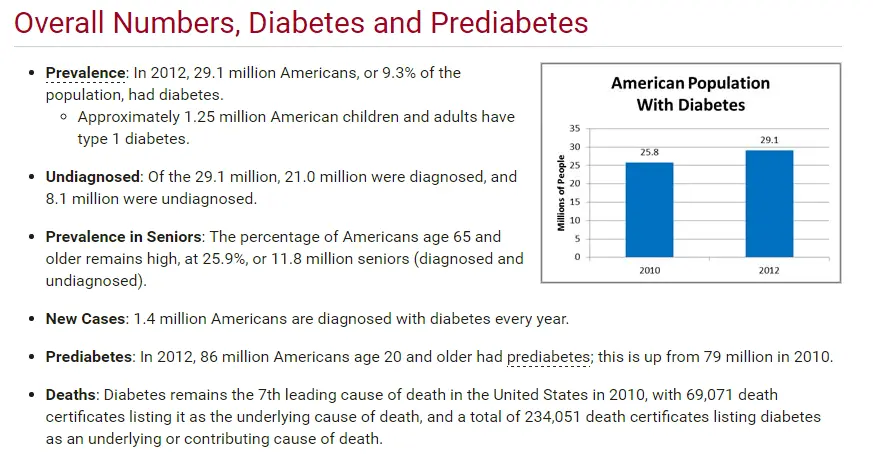
So there is about a 50% chance that this is happening inside your body as you are reading this.
Why is this a big deal?
Because high insulin sends the signal of growth to your body.
Insulin makes your fat cells bigger (2) (meaning you gain weight).
Insulin makes cancer cells grow (3).
Insulin increases your risk of heart disease (4), Alzheimer’s (5), and a bunch of other diseases (6) that you don’t want.
Important to this conversation I want to point a couple of things out.
Many of you may not be worried about cardiovascular disease or Alzheimer’s but you are probably worried about your weight.
At the end of the day, I don’t care what drives you to lower your insulin levels, the point is they need to be lowered.
You should also realize that while insulin levels are high it will basically be impossible for you to lose weight – even if you are dieting (7).
What’s worse is that some crash diets can actually stimulate insulin resistance when the body falsely believes you are in a period of “starvation”.
That’s why it’s so important to lower insulin levels in a healthy and safe way.
Treating Insulin Resistance
One of the main problems with insulin resistance is that our current paradigm in conventional medicine appears to be completely backward.
Even the diabetic association recommends eating carbohydrates multiple times per day with the use of insulin to help lower blood glucose levels.
Unfortunately, it has been shown through several studies (8) that simply lowering glucose levels actually has no benefit in reducing mortality and can actually INCREASE adverse events due to hypoglycemia.
This means we are basically just shuttling around glucose levels in the body and manipulating numbers to make us feel good.
That means in order to treat insulin resistance you will most likely have to go against the “conventional advice” of many doctors and nutritionists if you want to reverse your condition.
And despite what they may tell you, diabetes doesn’t have to be chronic or progressive.
I’ve successfully reversed insulin resistance in my practice (you can see the case study here) and I’m not the only one.
Unfortunately, the way to reverse your diabetes starts with ignoring all the rules:
So now that you know it IS possible, let’s take a look at how you can actually do it.
Diet and Insulin Resistance
One of the single most effective things you can do to reverse insulin resistance is to change your diet.
Now there are some good ways to do this and there are some bad ways to do this, so let’s talk about each one.
First, you need to realize that just going low carb may not be enough to lower your insulin levels and cause significant weight loss.
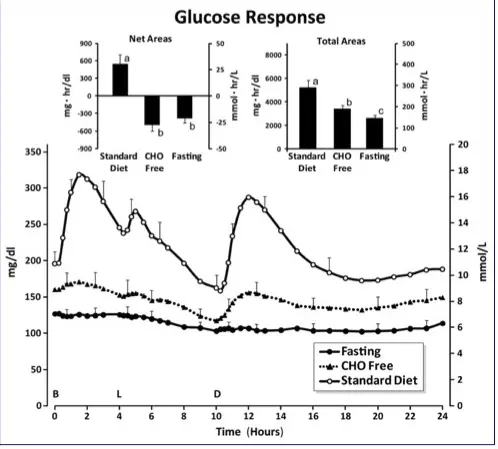
In many patients, a low-carb diet will simply NOT be enough to lower glucose levels.
Why?
I believe this is most likely secondary to other factors including how bad your insulin resistance is and other factors like hormone imbalances.
It is known that high levels of stress and other hormones can increase insulin levels (9).
I’ve found that one of the major drivers that potentiate insulin resistance in some patients is chronic and recurrent stress.
Death of family members, social stress, financial problems, etc.
All of these can potentiate cortisol levels and make insulin resistance worse.
In addition, I’ve found that hypothyroid patients tend to almost always have some degree of insulin resistance.
Most likely this is related to the fact that thyroid hormone plays some role in insulin signaling as you can see here (10).
Because of this, you will need to do more than just simply change your diet.
You will also have to address underlying hormone imbalances, reduce stress levels and make sure you are not eating too much of certain foods.
Let’s take a look at what I mean.
What foods to eat:
In general, I’ve had success in treating patients with insulin resistance when I have them consume raw, whole foods.
I’ve found that you don’t even really have to always avoid fruits and starchy vegetables as long as you incorporate fasting (not eating) into your regimen.
I’ve compiled a list of approved foods you should be enjoying on a daily basis (believe me the list is not restrictive).
- Vegetables: Artichokes, asparagus, bean sprouts, broccoli, Brussel sprouts, cabbage, collard greens, kale, mushrooms, tomatoes, summer squashes
- Fat: Coconut, avocado, olive oil, olives, nuts, and seeds (avoid peanuts) – almonds, cashews, hemp, chia, flax, etc.
- Fruits: Berries (blueberries, cranberries, raspberries), kiwi, lemons, and limes
- Protein: Chicken, turkey, duck, salmon, halibut, shrimp, eggs, sausage, bacon, deli meats, etc.
Instead of focusing on what foods to eat and what is “allowed” instead use this as a guide and ask yourself these questions:
Is this “real” food? (meaning was it created in a plant or did it come from the earth in some way)
Does this food have more than 3 ingredients?
Is this food “natural”?
Does this food make me feel good after I eat it?
Does this food have added sugars in it?
Does the food product say it is “low fat”?
If you answered yes to any of these questions then I would probably recommend against eating the food.
Remember:
When in doubt, leave it out.
What foods to avoid:
Talking about foods to avoid is probably easier than talking about foods you CAN eat.
In general, you want to avoid any and all food products that will be rapidly absorbed in your GI tract and that contain high amounts of sugar.
The hard part about this is that so many foods contain fructose or sugar in some form (it’s just usually hidden under some other name).
Foods to avoid when you have insulin resistance:
- Sugar – Any source of sugar including honey, added sugar like high fructose corn syrup (look on the back of food products), organic cane sugar, brown sugar, etc.
- Refined carbohydrates – This includes bread, pasta, bagels, pizza crust, muffins, tortillas, chips, etc.
- Beer and Alcohol – Consider these products liquid bread for lack of a better word, they will increase insulin levels and cause liver damage
As long as you actively avoid foods that are fake, processed, or have added sugar then you should be good to go here.
And yes, that means you will most likely have to start cooking food!
This will help reduce the number of processed foods you consume on a daily basis.
Portion sizes
Believe it or not, portion sizes are important but not THAT important.
Instead of focusing on how much food to eat, how much your food weighs, or how many ounces you are eating use this as a guideline:
Eat when your body is hungry and stop eating when it is full. Don’t count your calories and don’t overeat just to get certain foods into your diet. Listen to your body.
Now, this advice doesn’t always work – especially if you have leptin resistance along with your insulin resistance, but it’s a great place to start.
If you can’t “trust” your body then use these as general guidelines:
- Protein: 4-6 ounces at a time
- Fruit: 1/2-1 cup at a time
- Nuts: 1-2 handfuls
- Nut butter: 1-2 tablespoons
- Vegetables: 1/2 cup = 1 serving
- Healthy fats: 1 tablespoon
Notice I didn’t include how much you should be eating of each of these per day.
The reason is that each of you will need a unique amount of servings of the various macromolecules based on other medical conditions you may have which we will go over below.
Macromolecule Ratios
This is important because many people get this wrong.
The conventional approach to treating insulin resistance is to just simply go low carb.
But unfortunately, carbs aren’t the only macromolecule that increases insulin levels.
Both carbs and proteins can stimulate insulin production which means your diet should be both low in carbs AND proteins.
That means that most of the food you consume should be from high-quality fats.
A starting ratio should be something like this:
- 50-70% fat
- 20% protein
- 10-20% Carbohydrates
Mix and match these ratios based on how you feel and how active a lifestyle you live.
The more muscle mass you have the more protein you will need, the more activity you do the more carbs you will need, etc.
Just make sure that most of your food comes from high-quality fats without protein.
Other Diets for Insulin Resistance
If the advice above seems daunting or too difficult to follow then you can consider using other diets that have recipes and menus available online.
I’m specifically referring to two diets:
1. Atkins-type diet or Low carb diet
2. Nutritional ketosis or ketogenic diet
The Atkins diet has worked for many people in both helping with weight loss AND reducing insulin levels but you need to make sure you don’t eat a low-carb, high protein moderate-fat version.
That’s one way this diet will fail.
The other diet mentioned above is a VERY high-fat diet (usually 70% plus) with VERY low carbs (usually 10-25 grams per day).
It can also be helpful, but not everyone does well on this diet for various reasons.
Both Atkins and nutritional ketosis have been shown to help with weight loss (11) and reduce insulin levels (12).
So why choose one over the other?
It really depends on your body, how much insulin resistance you are dealing with, and what diet you are most likely to STICK to long term.
Intermittent + Prolonged fasting (Learning when NOT to eat)
Learning when NOT to eat is probably more important than learning what to eat when it comes to reversing insulin resistance.
Almost everyone focuses on carbs and diets because everyone talks about it, but what about fasting and not eating?
It turns out that going without food (intermittent fasting + prolonged fasting) is actually the best thing you can do to lower insulin and blood sugar levels.
Not only is fasting safe, but it’s also effective in helping with weight loss and increase resting energy expenditure (your metabolism).
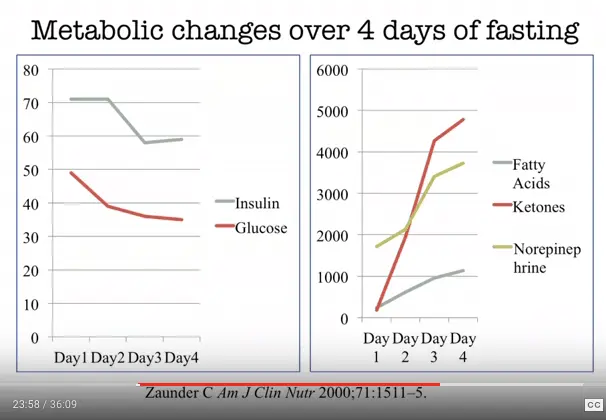
Fasting should be paired with supplements, medications, and diet to help the most with reducing insulin levels.
It’s also important to remember that you shouldn’t begin a fasting routine without some sort of physician supervision, especially if you have insulin resistance or if you are on diabetic medications.
Fasting drops blood sugar and theoretically could cause hypoglycemia in certain patients if they don’t know what to look out for.
Prolonged fasting can also act as prolonged calorie restriction if it is performed too often and ultimately cause metabolic damage and make insulin resistance worse.
It is very powerful if used correctly but likewise can be damaging if done incorrectly.
Treating Insulin Resistance Beyond Diet
As I mentioned previously dietary intervention is certainly important in the treatment of insulin resistance but you can take it several steps further by adding in other therapies.
Specifically, the use of medications, supplements, exercise, and lifestyle interventions can add a multiplicative effect to treating your insulin resistance.
This means that weight loss will be more profound and the lowering of your insulin levels will occur much more quickly when all of these therapies are added together.
The best part about the interventions I’m going to mention below is that they all have literary sources backing them up.
That means they have been shown in studies to help lower insulin levels, augment weight loss, or balance hormones.
I will provide relevant links when appropriate below.
Insulin Resistance Medications:
This is where things can get tricky.
Most diabetic medications are targeted at reducing blood sugar levels instead of focusing on reducing insulin levels themselves.
In fact, many diabetic medications cause an INCREASE in insulin in an effort to reduce blood sugar.
Does it make sense to increase insulin levels further if high insulin levels lead to insulin resistance in the first place?
Not really – but this is how many medications work.
If you remember what we discussed above you will recall that reducing blood sugar levels makes us feel good, but it doesn’t always (or necessarily) reduce adverse events or help patients live longer.
Having said that there are several diabetic medications that actually help lower insulin AND blood sugar levels which results in a reduction in insulin resistance.
Coincidentally it is these medications that almost always result in weight loss as well.
Compare that with the treatment of other diabetic medications like insulin itself, and you will find that it almost always causes weight GAIN (13).
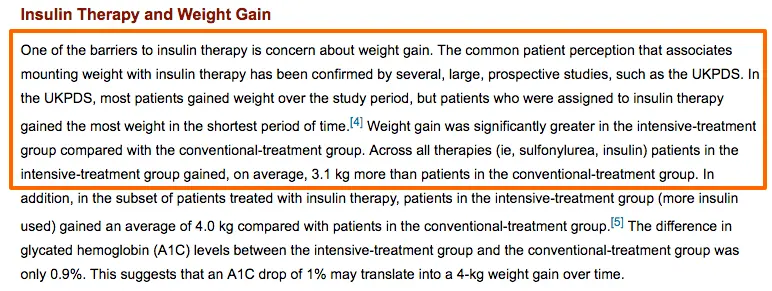
It doesn’t take a genius to figure out that causing weight gain in a diabetic is certainly not a good thing, but this is the reality of the situation.
Instead of focusing on those types of medications, I’m going to list out medications that may actually help:
1. GLP-1 Agonists
These medications act by reducing glucagon in the body.
Gluca-what?
Glucagon basically does the exact opposite thing insulin does. Glucagon INCREASES blood sugar.
We tend to focus only on insulin but glucagon is important because when insulin becomes dysregulated it’s also possible for glucagon to become dysregulated as well.
Glucagon issues lead to chronically elevated levels of glucose even when fasting which can make lowering insulin and thus reversing insulin resistance very difficult with dietary changes alone.
The GLP-1 agonists help stop glucagon from increasing your blood sugar which keeps blood sugar low.
They also can cause a slowing down of the stomach known as delayed gastric emptying.
And in this case, it’s a side effect we are actually looking for. It means the medication is working.
Medications in this class of drugs include: Byetta, Victoza, Bydureon, Saxenda, and Trulicity
Here’s where things get tricky:
I’ve found these medications to be superior in terms of how effective they are at reducing insulin levels, and leptin levels and helping with weight loss when compared to metformin.
They tend to be expensive, but whenever possible I use these as first-line agents in patients with insulin resistance.
This class of medication is helpful in helping patients lose weight (14), reduce leptin (15) levels, and reverse insulin resistance (16).
Of note: these medications have been associated with an increased risk of pancreatic cancer and pancreatitis if used in the long-term setting.
When using them as I suggest the treatment duration is shorter and therefore side effects are less likely.
Some studies (17) have also shown the risk to be very small or non-existent.
2. SGLT-2 Inhibitors
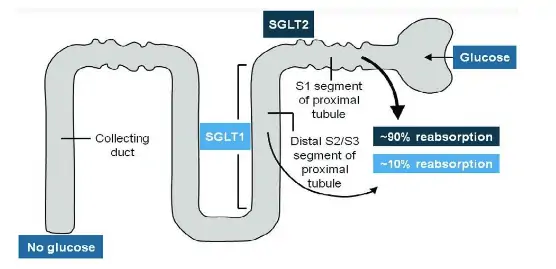
SGLT-2 inhibitors work by blocking the absorption of glucose in the kidneys.
Basically, they change the way your kidneys work and cause you to pee out sugar/glucose in your urine.
This is actually really interesting because most medications focus on simply moving glucose and sugar into and out of cells, they don’t actually get RID of the sugar in your body.
These medications are unique in the sense that they help your body ELIMINATE the sugar which sensitizes your body to insulin.
These medications also help with weight loss (18), but in my experience are not quite as effective as the GLP-1 agonists.
They are potent when combined with other medications and as long as they are coupled with proper dietary recommendations and supplements.
3. Metformin
This medication has been around for a long time and is quite cheap.
For this reason, it’s often used as a first-line medication for pre-diabetes and diabetes.
Metformin has been shown to help with weight loss (19) in both diabetic and non-diabetic populations (those with insulin resistance), but this effect seems to be small if used by itself.
Metformin can be helpful if you are dealing with an isolated cause of insulin resistance and don’t have other hormone imbalances like leptin resistance or hypothyroidism.
If used by itself without dietary interventions this medication will NOT cause significant weight loss.
The fact that this medication is cheap and most doctors won’t think twice about prescribing it may make it easy to acquire if your Doctor isn’t willing to work with you and you have only a slight degree of insulin resistance.
4. Alpha-glucosidase inhibitor (Acarbose)
This is another interesting medication that isn’t prescribed very often.
It acts by preventing the breakdown and absorption of sugar and carbs in the GI tract.
So it helps your body prevent absorbing carbohydrates in case you consume them.
I’m generally not a fan of this mechanism of action because it may promote patients to continue to eat unhealthy which would still cause an increase in insulin if they consume sugars and carbs.
It can still be effective in helping with weight loss (20) in patients who consume higher quantities of carbohydrates, but I wouldn’t jump to this medication as first-line therapy.
Despite this, it can actually help improve GI function in many diabetics by increasing helpful and beneficial bacteria in the GI tract.
If you don’t break down the glucose and carbs for YOUR body your GI bugs can still consume them and thus grow.
As they grow they can help reduce inflammatory levels (21) and improve GI function in some patients.
As a general rule, I don’t recommend the use of medications by themselves, but if combined with all of these treatments they can be very potent.
Insulin Resistance Supplements
While you might be focusing on medication and diet there are some supplements that are very effective at reducing insulin levels and sensitizing your body to insulin.
In fact, some supplements (I’m looking at you Berberine) have been shown to reduce the Hgb A1c as much as the medication metformin (22).
In addition, many of you are probably deficient in some of these nutrients, so replacing them is not treatment, as much as it is replacing what your body is already deficient in.
In some cases, these nutrient deficiencies can predispose you or make it easier for you, to develop insulin resistance.
Supplements that treat insulin resistance:
- Berberine – This supplement helps lower blood sugar, improves cholesterol levels (23), and can help with weight loss.
- Alpha Lipoic acid – ALA can help improve insulin sensitivity, reduce inflammation (24), and can even help treat peripheral neuropathy (25) in diabetic patients.
- Chromium – Chromium helps increase insulin sensitivity (26) and may help reduce the risk of cardiovascular disease.
- Curcumin – In 1 study patients (27) who were pre-diabetic and took curcumin had a significantly lower chance of developing type II diabetes, in addition, it helps reduce inflammation and may help improve pancreatic function.
To get the most benefit you will need to use supplements + medications + diet above.
Using these supplements by themselves will NOT result in significant improvement.
Lifestyle Interventions
We can’t have a conversation about reversing insulin resistance without at least mentioning stress reduction AND exercise.
The lack of exercise can make insulin resistance and high-stress levels can increase cortisol which also makes insulin resistance worse.
While exercising will most likely NOT cause a significant reduction in weight, it can help promote insulin sensitivity and help everything else lead to weight loss.
I’m not trying to tell you that the key to weight loss and reversing your diabetes is “eat less and exercise more”, but there is some truth to the exercise more part.
This is also important because most people do the wrong kind of exercise.
You know, those people who get to the gym and sit on the treadmill for an hour and claim they burned 1,000 calories, and yet they never actually lose weight.
Does this sound familiar?
Aside from the fact that your body doesn’t actually burn that many calories while exercising, that type of exercise also doesn’t lead to significant changes in insulin sensitivity in the body.
Instead of focusing on low-intensity or “cardiovascular exercise” it’s better to exercise LESS but more intensely.
I’m referring to two specific types of exercise:
1. High-intensity interval training or HIIT
2. Slow weight training or weight training of any type
Spending 10-20 minutes 1-3x per week is more effective at reducing insulin levels and helping weight loss (28) than sitting on a treadmill for 60 minutes each day.
In addition to HIIT, I also recommend using some combination of weight training.
The goal here is to build muscle mass to help increase resting energy expenditure, increase insulin sensitivity and help increase your metabolism.
I specifically recommend slow weight training for patients with insulin resistance but in reality, most forms of weight training will help as well.
Blowing steam at the gym or inside your house will also help reduce cortisol levels (29) and reduce stress levels.
It’s a win-win.
Wrapping it up
Insulin resistance is a serious issue but there are ways that you can go about lowering your insulin levels and reversing insulin resistance.
By far one of the most effective ways is to change your diet:
That means eating the right foods, avoiding the wrong foods, and learning when not to eat.
Changing your diet and combining medications, supplements, and lifestyle interventions is by far the best way to reverse insulin resistance.
Using this strategy you can effectively lose weight and start feeling better.
Now it’s your turn:
Are you dealing with insulin resistance?
What has helped you lose weight or reverse your insulin levels?
What advice do you have for others in your situation?
Leave a comment below!
